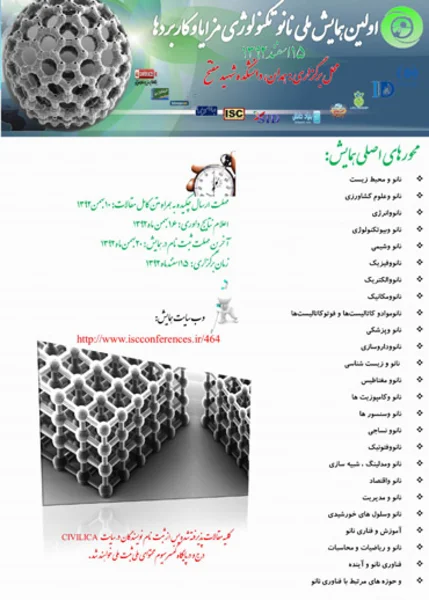-
a survey upon sensing of mercury(ii), containing nanopollutants by using an ionic liquid
جزئیات بیشتر مقاله- تاریخ ارائه: 1392/12/02
- تاریخ انتشار در تی پی بین: 1392/12/02
- تعداد بازدید: 359
- تعداد پرسش و پاسخ ها: 0
- شماره تماس دبیرخانه رویداد: -
the rapid maturing of nanotechnology and its wide range of applications not bring benefits only, so the downsides are worth noting. nanopollutants, generally undetectable, are often found as byproducts involved in various chemical or physical reactions. many nanopollutants are concerned and suspected of causing negative impact on human health due to their unpredictable existence in the environment. unlike the traditional sensing systems which can detect select gaseous molecules, effective nanoparticle sensing methods are still lacking in the literature. in this paper, sensing of mercury(ii)-containing nanopollutants suspended in n2 with a room-temperature ionic liquid (rtil) ([c4 mim][pf6] (1-butyl-3-methyl imidazolium hexafluorophosphate)) has been studied. the sensitivities (ril /rnano ) obtained by determination of the rtil resistance to the absorbed phosphor fly ash (<200 nm) is 7.0, while the rtil has higher sensitivity of 11 and 10, respectively, to hgo and hgs nanoparticles by component- fitted x-ray absorption near edge structure (xanes) spectroscopy, it seems that the n-methyl imidazole (mim) complexes are formed during sensing of the phosphor fly ash, hgo and hgs nanoparticles with the rtil. the 1 h and 31 p nmr observations also suggest that the (mim) behaves as a carrier during sensing of nanopollutants with the rtil.
مقالات جدیدترین رویدادها
-
استفاده از تحلیل اهمیت-عملکرد در ارائه الگوی مدیریت خلاقیت سازمانی و ارائه راهکار جهت بهبود
-
بررسی تاثیر ارزش وجوه نقد مازاد بر ساختار سرمایه شرکت های پذیرفته شده در بورس اوراق بهادار تهران
-
بررسی تأثیر سطح افشای ریسک بر قرارداد بدهی شرکت های پذیرفته شده در بورس اوراق بهادار تهران
-
بررسی تأثیر رتبه بندی اعتباری مبتنی بر مدل امتیاز بازار نوظهور بر نقد شوندگی سهام با تأکید بر خصوصی سازی شرکت ها
-
تأثیر آمیخته بازاریابی پوشاک ایرانی بر تصویر ذهنی مشتری پوشاک ایرانی (هاکوپیان)
-
مدل سازی المان محدود ستون های فولادی نیمه مدفون در بتن با مقاطع h شکل ساخته شده از ورق های لاغر
-
مدل سازی تعادل بخار –مایع سیستم های دی اکسید کربن –پروپان و دی اکسید کربن –اکتان با استفاده از یک عبارت قطبی در معادله حالت spc-saft-d
-
بررسی رابطه میان اضطراب و یادگیری در مدارس مقطع متوسطه اول شهر شیرگاه
-
دیدگاه معلم در مورد روش اسکرام در آموزش شیمی متوسطه
-
مدل سازی تاثیر تزریق گاز امتزاجی بر ناپایداری رسوبات آسفالتین در مخازن نفتی
مقالات جدیدترین ژورنال ها
-
مدیریت و بررسی افسردگی دانش آموزان دختر مقطع متوسطه دوم در دروان کرونا در شهرستان دزفول
-
مدیریت و بررسی خرد سیاسی در اندیشه ی فردوسی در ادب ایران
-
واکاوی و مدیریت توصیفی قلمدان(جاکلیدی)ضریح در موزه آستان قدس رضوی
-
بررسی تاثیر خلاقیت، دانش و انگیزه کارکنان بر پیشنهادات نوآورانه کارکنان ( مورد مطالعه: هتل های 3 و 4 ستاره استان کرمان)
-
بررسی تاثیر کیفیت سیستم های اطلاعاتی بر تصمیم گیری موفق در شرکتهای تولیدی استان اصفهان (مورد مطالعه: مدیران شرکتهای تولیدی استان اصفهان)
-
بررسی استقلال شرط ارجاع به داوری در قرارداد ها تجاری
-
رهبری تحول گرا، شرایط نوآوری، اثر بخشی مستقل و خلاقیت کارمندان: یک بررسی چند سطحی
-
نقش نگرش دیالکتیکی در پیدایش گونه های شخصیتی تازه در رمان فارسی (با رویکرد به رمان هم نوایی شبانه ارکستر چوبها)
-
بررسی رابطه بین دوره تصدی حسابرس و دانش مالی اعضای هیئت مدیره با حق الزحمه حسابرسی
-
تحلیل محتوی کتاب های علوم دوره اول متوسطه تحصیلی از لحاظ توجه به معضلات زیست محیطی




سوال خود را در مورد این مقاله مطرح نمایید :